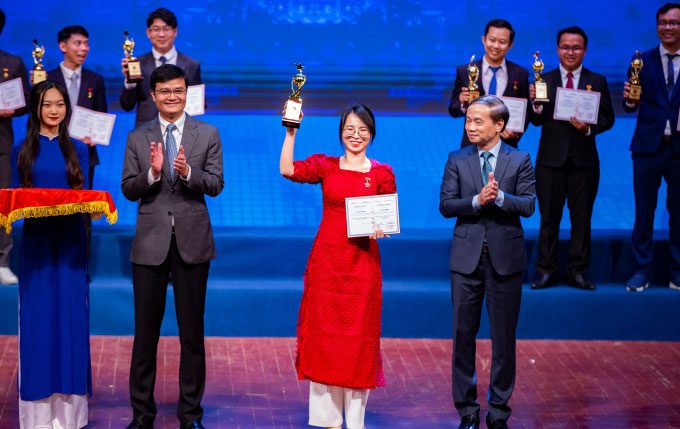Dr. Le Thi Phuong (34 years old) has been awarded an international patent for creating a hydrogel with multiple new properties that enhances the process of bone differentiation and has applications in treating orthopedic diseases.
During the 2022 Golden Globe Awards, Dr. Le Thi Phuong from the Institute of Applied Materials Science, Vietnam Academy of Science and Technology (VAST), was one of the ten young scientists honored for her impressive research achievements. Over more than ten years of dedication, she holds 2 international patents, 3 national patents, and has published dozens of international research articles.
Among her published research, Dr. Phuong has devoted significant time to developing new materials with high biocompatibility, such as hydrogels and nano-structured particles that aid in the treatment of various ailments including soft tissue injuries (bleeding, burns, cuts, etc.), bone fractures, cancer, and diabetes.

Dr. Le Thi Phuong (center) honored at the 2022 Golden Globe Awards. (Photo: Tung Dinh).
The hydrogel material is the first research project in the field of injectable hydrogels that does not use H2O2, conducted by Dr. Phuong. This material offers various benefits such as antibacterial properties, promoting bone differentiation, and has broad applications in tissue regeneration or treating diseases related to joints.
The research team utilized natural-origin polymers such as gelatin, chitosan, alginate, combined with calcium peroxide (CaO2) as a hydrogen peroxide generating agent to facilitate the enzyme-catalyzed gel formation process while enhancing the biological activities of the hydrogel system. Accordingly, the physical-mechanical properties of the hydrogel, such as gelation rate, mechanical strength, and degradation time, can be easily adjusted through the amount of CaO2. The results show that the hydrogel system exhibits high adhesion, inhibits the growth of bacteria like E. coli and S. aureus, and promotes the proliferation and differentiation of mesenchymal stem cells into bone cells.
According to Dr. Phuong, Vietnam has a rich source of medicinal herbs for wound healing that is often used in traditional remedies. Therefore, utilizing available herbal extracts (from plants like Centella Asiatica, fish mint, aloe vera, etc.) when mixed with natural polymers to create a new hydrogel system with superior properties (quick hemostasis, anti-inflammatory, antibacterial, reduced scar formation) holds great potential for future research, with the main goal of creating a commercial medical product that can heal wounds quickly, effectively, and at a reasonable cost, thus improving patient care.
Dr. Phuong’s research team is currently advancing experiments on various animal models to progress towards clinical trials on humans.
Her journey into hydrogel research began in the early years at the Institute of Applied Materials Science (Vietnam Academy of Science and Technology). A former chemical engineering student from the University of Science and Technology (Vietnam National University, Ho Chi Minh City), she later pursued her doctoral studies at Ajou University in South Korea. “Ten years in South Korea, a journey not short, filled with sweat and tears,” Phuong recalls. In return, the sweet fruit she gained was an international patent registered in the U.S. for her research on injectable hydrogels using various cyclodextrins, which provided the gel with high adhesion and promoted the biomedical application of these hydrogels.
The uniqueness of this invention is that the material can quickly transition from a liquid to a solid phase (within seconds to a minute) allowing for rapid coverage and good adhesion on the wound surface, thereby controlling bleeding and promoting the healing process. The hydrogel system is applied in biomedicine to facilitate quick wound healing and tissue regeneration. People can use it at home without needing to go to the hospital, nor requiring the skills of medical professionals for traditional surgical methods, thus reducing pressure on the healthcare system.
One study involves an injectable hydrogel using copper nanoparticles as a catalyst for the production of nitric oxide (a gas that plays a signaling role in various physiological and pathological processes in the body). Another research focus examines hydrogels based on gelatin/chitosan and polyethylene glycol for various biomedical applications. Due to the success of her work, she received the award for Outstanding Female Scientist from the Korean Society for Biomaterials in 2021.
Associate Professor Dr. Tran Ngoc Quyen, Director of the Institute of Applied Materials Science, noted that Dr. Phuong is always full of enthusiasm and passion for science. They have known each other for a long time, first as researchers in South Korea and then as colleagues at the Institute of Applied Materials Science. He shared that despite the excellent career path and benefits in South Korea, Phuong accepted his invitation to return to Vietnam. “Phuong has a good research orientation, guiding thinking, sensitivity, and perseverance in every project she participates in,” Associate Professor Quyen shared with the reporter.
In addition to injectable hydrogels, Dr. Phuong is also developing new nano-sized materials for the slow release of cancer treatment drugs, primarily aimed at reducing the body’s drug clearance and the side effects of drugs on healthy cells, thanks to the targeting and responsiveness of these nano systems to cancer cells. Research is also being focused on modifying the surfaces of cardiovascular support devices (such as stents, vascular grafts, catheters) to prevent thrombosis at the interfaces between the implanted materials and blood.
Specifically in this field, Dr. Phuong has researched and developed a dual-functional surface by combining the therapeutic effects of both heparin (a common anticoagulant) and nitric oxide (NO, a signaling molecule that can dilate blood vessels and increase blood flow by reducing platelet activation and regulating blood vessel cell behavior), thereby reducing the risk of rejection of implanted devices in the treatment of cardiovascular diseases. The research results have been published in the Journal of Controlled Release and the patent was registered in the U.S. in 2017.


















































